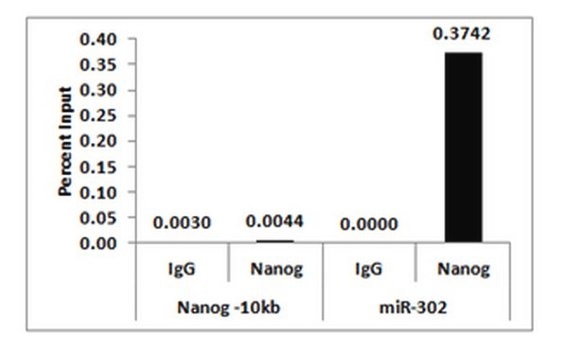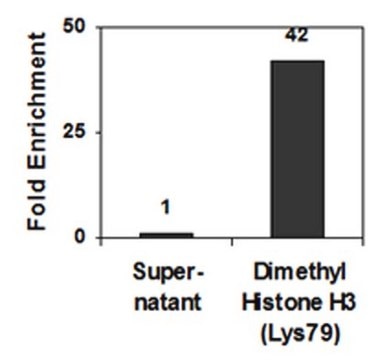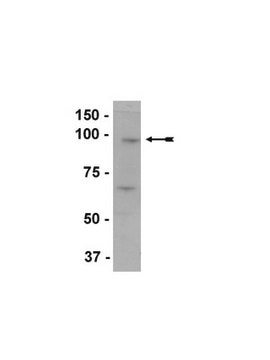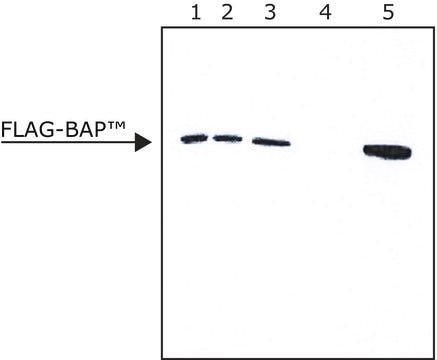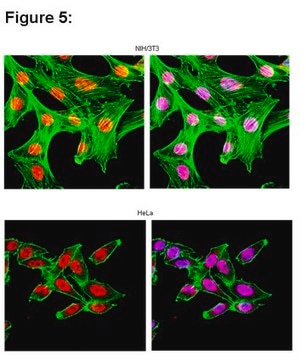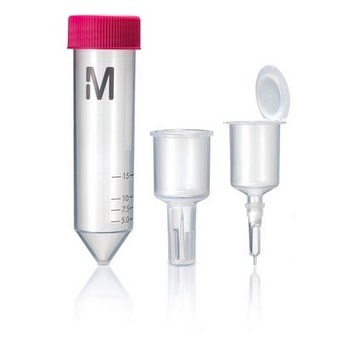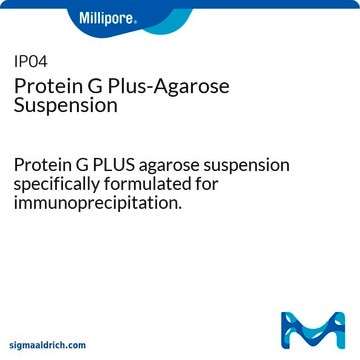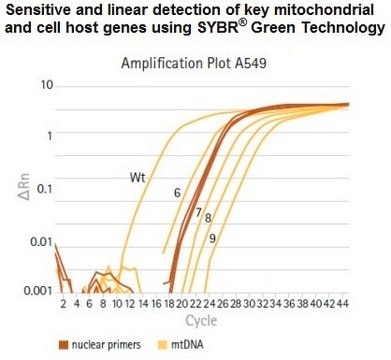03-119
RIPAb+ CUGBP2 - RIP Validated Antibody and Primer Set
from mouse
Sign Into View Organizational & Contract Pricing
All Photos(3)
About This Item
UNSPSC Code:
12352203
eCl@ss:
32160702
NACRES:
NA.52
Recommended Products
biological source
mouse
Quality Level
clone
monoclonal
species reactivity
human
manufacturer/tradename
RIPAb+
Upstate®
technique(s)
RIP: suitable
immunoprecipitation (IP): suitable
western blot: suitable
isotype
IgG1
NCBI accession no.
UniProt accession no.
shipped in
dry ice
Gene Information
human ... CELF2(10659)
Related Categories
General description
RIPAb+ antibodies are evaluated using the RNA Binding Protein Immunoprecipitation (RIP) assay. Each RIPAb+ antibody set includes a negative control antibody to ensure specificity of the RIP reaction and is verified for the co-immunoprecipitation of RNA associated specifically with the immunoprecipitated RNA binding protein of interest. Where appropriate, the RIPAb+ set also includes quantitative RT-PCR control primers (RIP Primers) to biologically validate your IP results by successfully co-precipitating the specific RNA targets, such as messenger RNAs. The qPCR protocol and primer sequences are provided, allowing researchers to validate RIP protocols when using the antibody in their experimental context. If a target specific assay is not provided, the RIPAb+ kit is validated using an automated microfluidics-based assay by enrichment of detectable RNA over control immunoprecipitation.
CUGBP2 is a RNA-binding protein implicated in the regulation of several post-transcriptional events including pre-mRNA alternative splicing, mRNA translation and stability. CUGBP2 mediates exon inclusion and/or exclusion in pre-mRNA that are subject to tissue-specific and developmentally regulated alternative splicing.
CUGBP2 is a RNA-binding protein implicated in the regulation of several post-transcriptional events including pre-mRNA alternative splicing, mRNA translation and stability. CUGBP2 mediates exon inclusion and/or exclusion in pre-mRNA that are subject to tissue-specific and developmentally regulated alternative splicing.
Specificity
CuGBP2
Other species have not yet been tested.
Immunogen
A synthetic peptide corresponding to amino acids 209-415 of human CuGBP2.
Application
Immunoprecipitation from RIP lysate:
Representative lot data.
RIP lysate from Jurkat cells (~5 X 10E7 cell equivalents per IP) was subjected to immunoprecipitation using 5 µg of either a normal mouse IgG, (Cat. #CS200621), or 5 µg of Anti-CUGBP2 antibody (Cat. # CS204360).
Precipitated proteins (lane 1: mouse IgG, lane 2: anti-CUGBP2) were resolved by electrophoresis, transferred to nitrocellulose and probed with anti-CUGBP2 antibody (Cat. # CS204360, 1:1000). Proteins were visualized using One-Step IP-Western kit (GenScript Cat. # L00231)
Arrow indicates CUGBP2 (Figure 2).
Western Blot Analysis:
Representative lot data.
Lysates from HL60 cells were probed with a previous lot of Anti-CUGBP2 (1:1000 dilution).
Arrow indicates CUGBP2 ~56 kDa (Figure 3).
Representative lot data.
RIP lysate from Jurkat cells (~5 X 10E7 cell equivalents per IP) was subjected to immunoprecipitation using 5 µg of either a normal mouse IgG, (Cat. #CS200621), or 5 µg of Anti-CUGBP2 antibody (Cat. # CS204360).
Precipitated proteins (lane 1: mouse IgG, lane 2: anti-CUGBP2) were resolved by electrophoresis, transferred to nitrocellulose and probed with anti-CUGBP2 antibody (Cat. # CS204360, 1:1000). Proteins were visualized using One-Step IP-Western kit (GenScript Cat. # L00231)
Arrow indicates CUGBP2 (Figure 2).
Western Blot Analysis:
Representative lot data.
Lysates from HL60 cells were probed with a previous lot of Anti-CUGBP2 (1:1000 dilution).
Arrow indicates CUGBP2 ~56 kDa (Figure 3).
Research Category
Protein Trafficking
Epigenetics & Nuclear Function
Protein Trafficking
Epigenetics & Nuclear Function
Research Sub Category
RNA Metabolism & Binding Proteins
RNA Binding Protein (RBP)
RNA Metabolism & Binding Proteins
RNA Binding Protein (RBP)
This RIPAb+ CUGBP2 -RIP Validated Antibody & Primer Set conveniently includes the antibody & the specific control PCR primers.
Packaging
10 assays per set. Recommended use: ~5 μg of antibody per RIP (dependent upon biological context).
Quality
RNA Binding Protein Immunoprecipitation:
RIP Lysate prepared from Jurkat cells (~5 X 10E7 cell equivalents per IP) were subjected to immunoprecipitation using 5 µg of either a normal mouse IgG (Cat. # CS200621), or 5 µg of Anti-CUGBP2 antibody (Cat. # CS204360) and the Magna RIP® RNA-Binding Protein Immunoprecipitation Kit (Cat. # 17-700).
Successful immunoprecipitation of CUGBP2-associated RNA was verified by qPCR using RIP Primers Jun, (Cat. # CS203198) (Figure 1).
Please refer to the Magna RIP (Cat. # 17-700) or EZ-Magna RIP (Cat. # 17-701) protocol for experimental details.
RIP Lysate prepared from Jurkat cells (~5 X 10E7 cell equivalents per IP) were subjected to immunoprecipitation using 5 µg of either a normal mouse IgG (Cat. # CS200621), or 5 µg of Anti-CUGBP2 antibody (Cat. # CS204360) and the Magna RIP® RNA-Binding Protein Immunoprecipitation Kit (Cat. # 17-700).
Successful immunoprecipitation of CUGBP2-associated RNA was verified by qPCR using RIP Primers Jun, (Cat. # CS203198) (Figure 1).
Please refer to the Magna RIP (Cat. # 17-700) or EZ-Magna RIP (Cat. # 17-701) protocol for experimental details.
Target description
56 kDa
Physical form
Anti-CUGBP2 (Mouse Monoclonal), Part # CS204360. One vial containing 50 µg of protein A purified mouse monoclonal IgG1 in 50 µL of 1X PBS, pH 7.0, and 0.1% sodium azide, before the addition of 30% glycerol. Store at -20°C.
Normal Mouse IgG, Part # CS200621. One vial containing 125 µg of purified mouse IgG in 125 µL of storage buffer containing 0.1% sodium azide. Store at -20°C.
RIP Primers, JUN, Part # CS203198.
One vial containing 75 μL of 5 μM of each primer specific for the cDNA of human JUN.
Store at -20°C.
FOR: TCG ACA TGG AGT CCC AGG A
REV: GGC GAT TCT CTC CAG CTT CC
Normal Mouse IgG, Part # CS200621. One vial containing 125 µg of purified mouse IgG in 125 µL of storage buffer containing 0.1% sodium azide. Store at -20°C.
RIP Primers, JUN, Part # CS203198.
One vial containing 75 μL of 5 μM of each primer specific for the cDNA of human JUN.
Store at -20°C.
FOR: TCG ACA TGG AGT CCC AGG A
REV: GGC GAT TCT CTC CAG CTT CC
Format: Purified
Protein A purified
Storage and Stability
Stable for 1 year at -20°C from date of receipt.
Handling Recommendations: Upon receipt, and prior to removing the cap, centrifuge the vial and gently mix the solution. Aliquot into microcentrifuge tubes and store at -20°C. Avoid repeated freeze/thaw cycles, which may damage IgG and affect product performance.
Handling Recommendations: Upon receipt, and prior to removing the cap, centrifuge the vial and gently mix the solution. Aliquot into microcentrifuge tubes and store at -20°C. Avoid repeated freeze/thaw cycles, which may damage IgG and affect product performance.
Analysis Note
Control
Includes negative control mouse IgG antibody and control primers specific for the cDNA of human JUN.
Includes negative control mouse IgG antibody and control primers specific for the cDNA of human JUN.
Other Notes
Concentration: Please refer to the Certificate of Analysis for the lot-specific concentration.
Legal Information
MAGNA RIP is a registered trademark of Merck KGaA, Darmstadt, Germany
UPSTATE is a registered trademark of Merck KGaA, Darmstadt, Germany
Disclaimer
Unless otherwise stated in our catalog or other company documentation accompanying the product(s), our products are intended for research use only and are not to be used for any other purpose, which includes but is not limited to, unauthorized commercial uses, in vitro diagnostic uses, ex vivo or in vivo therapeutic uses or any type of consumption or application to humans or animals.
wgk_germany
WGK 2
Certificates of Analysis (COA)
Search for Certificates of Analysis (COA) by entering the products Lot/Batch Number. Lot and Batch Numbers can be found on a product’s label following the words ‘Lot’ or ‘Batch’.
Already Own This Product?
Find documentation for the products that you have recently purchased in the Document Library.
André Markmann et al.
European journal of cell biology, 82(3), 119-129 (2003-04-15)
During atherogenesis vascular smooth muscle cells are converted from a contractile into a synthetic phenotype characterized by enhanced matrix production. The transcription factors Gax and GATA-6 are considered negative, and Oct-1 positive regulators of the synthetic phenotype. Since the phenotype
Our team of scientists has experience in all areas of research including Life Science, Material Science, Chemical Synthesis, Chromatography, Analytical and many others.
Contact Technical Service